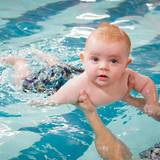Teaching kids how to float in water
|
Not only does teaching your kids how to float provide them with a strong foundation for learning to swim, it’s also one of the most important core water safety skills they can learn from an early age.
|
You might also be interested in ...
5 Benefits of starting swimming lessons as a baby
Starting swimming lessons as a baby comes with many benefits including improved physical, emotional, social and cognitive development. It also sets a positive foundation towards a lifetime of participation and enjoyment in a variety of water sports and time spent on, in and under the water. On the whole, children who start swimming lessons early are far more relaxed and happy in the water, and in a country as water-loving as New Zealand, this is vital.
The social benefits of swimming for babies
A weekly swimming lesson is often a child’s first social experience out of the home that involves their peers. They learn to relate and interact with each other and look forward to seeing their classmates each week, and even watch them for cues when it comes to taking risks and learning something new. The best way for babies to learn is by example, and as they are with children their own age, a lot of fun goes along with it.







The first stage is to ensure that your kids feel comfortable in and around water. Then you can teach them how to put their head underwater, before embarking on the final stage which is teaching them how to float when they’re in water.
Not only does teaching your kids how to float provide them with a strong foundation for learning to swim, it’s also one of the most important core water safety skills they can learn from an early age.
Remember to praise and encourage your kids as they learn this new skill.
Being able to float may take some time for them to grasp and for them to feel completely comfortable in the water.
Teaching kids how to float in water
Learning how to float on their front or back doesn’t always come naturally for kids.
Children are born with an inherent fear of falling, meaning that they think if they lie back in a floating position they will fall and hurt themselves. They don’t understand that the water will actually keep them afloat.
Their fear can also limit their ability to breathe deeply and inflate their lungs with air. Lungs are like natural buoys and when filled with air, will help your kids to rise to the surface of the water.
So even before heading to the pool, parents should practice taking deep breaths with their kids.
Teaching kids to float on their back
Start by teaching your kids to float on their back, before floating on their front.
Floating on their back helps them to breathe more easily than when they’re floating on their front, and allows them to shout for help if they need to.
The goal is to teach them how to lie with their whole body on the surface, face above water, eyes looking up.
Here are some easy steps to follow.
1. Get your kids to lie their head back on your shoulder, treating it like a pillow.
Use your hands to support their back and remind them to keep their head back and belly up to help keep themselves on the surface.
2. Get your kids to spread their legs and arms out like a starfish.
Pretending to be a starfish will help make them less tense and will ensure that they have more surface area to float on.
3. As your kids get more confident in the water, move their head off your shoulder so it rests on the surface of the water, but still keep your hand on their back.
4. Gradually start to support them with fewer fingers, eventually getting down to one hand, and then to independent floating.
Teaching kids to float on their front
To be able to float on their front, your kids first need to feel comfortable putting their face in the water and holding their breath. The longer they can hold their breath, the longer they will float!
When it comes to floating on their front, get your kids to extend their arms and legs into a starfish shape, face down in the water looking at the bottom of the pool.
They can either hold onto a step in the pool or you can hold their stomach to help lift their body closer to the surface of the water.
With time, you can gradually start to give your kids body less support and move slowly away from the steps to the middle of the pool.
Source: This article was kindly written for us by SplashSave - giving parents all the tools they need to teach their kids to swim & to ensure they grow up safe around water.
Visit www.splashsave.co.nz to learn more about teaching your kids to swim and to get a big discount off your SplashSave Parents Pack when you use code ‘under5s’.
Image source: RockfordRegisterStar